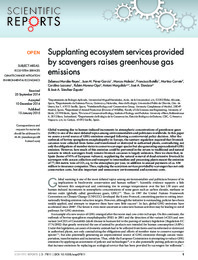Por favor, use este identificador para citar o enlazar este ítem:
https://hdl.handle.net/11000/1918Registro completo de metadatos
| Campo DC | Valor | Lengua/Idioma |
|---|---|---|
| dc.contributor.author | Sánchez Zapata, José Antonio | - |
| dc.contributor.author | Morales Reyes, Zebensui | - |
| dc.contributor.author | Pérez García, Juan M. | - |
| dc.contributor.author | Moleón, Marcos | - |
| dc.contributor.author | Botella Robles, Francisco | - |
| dc.contributor.author | Carrete, Martina | - |
| dc.contributor.author | Lazcano, Carolina | - |
| dc.contributor.author | Moreno Opo, Rubén | - |
| dc.contributor.author | Margalida, Antoni | - |
| dc.contributor.author | Donázar, José A. | - |
| dc.contributor.other | Departamentos de la UMH::Biología Aplicada | es |
| dc.date.accessioned | 2015-10-07T14:28:20Z | - |
| dc.date.available | 2015-10-07T14:28:20Z | - |
| dc.date.created | 2015-01-15 | - |
| dc.date.issued | 2015-10-07 | - |
| dc.identifier.uri | http://hdl.handle.net/11000/1918 | - |
| dc.description.abstract | Global warming due to human-induced increments in atmospheric concentrations of greenhouse gases (GHG) is one of the most debated topics among environmentalists and politicians worldwide. In this paper we assess a novel source of GHG emissions emerged following a controversial policy decision. After the outbreak of bovine spongiform encephalopathy in Europe, the sanitary regulation required that livestock carcasses were collected from farms and transformed or destroyed in authorised plants, contradicting not only the obligations of member states to conserve scavenger species but also generating unprecedentedGHG emission. However, how much of this emission could be prevented in the return to traditional and natural scenario in which scavengers freely remove livestock carcasses is largely unknown. Here we show that, in Spain (home of 95% of European vultures), supplanting the natural removal of dead extensive livestock by scavengers with carcass collection and transport to intermediate and processing plants meant the emission of 77,344 metric tons of CO2 eq. to the atmosphere per year, in addition to annual payments of ca. $50 million to insurance companies. Thus, replacing the ecosystem services provided by scavengers has not only conservation costs, but also important and unnecessary environmental and economic costs. | es |
| dc.description.sponsorship | This work was funded by the Spanish MINECO (grant CGL2012-40013-C02-02) | - |
| dc.format | application/pdf | es |
| dc.format.extent | 6 | es |
| dc.language.iso | eng | es |
| dc.rights | info:eu-repo/semantics/openAccess | es |
| dc.subject | ecology | es |
| dc.subject | greenhouse effect | es |
| dc.subject | environmental economics | es |
| dc.subject.classification | Ecología | es |
| dc.subject.other | CDU: 504 - Ciencias del medio ambiente | es |
| dc.title | Supplanting ecosystem services provided by scavengers raises greenhouse gas emissions | es |
| dc.type | info:eu-repo/semantics/article | es |
| dc.identifier.doi | 10.1038/srep07811 | - |
| dc.relation.publisherversion | http://dx.doi.org/10.1038/srep07811 | - |

Ver/Abrir:
CGL2012-40013-C02-02_sanchez_supplanting.pdf
820,32 kB
Adobe PDF
Compartir:
 La licencia se describe como: Atribución-NonComercial-NoDerivada 4.0 Internacional.
La licencia se describe como: Atribución-NonComercial-NoDerivada 4.0 Internacional.
.png)